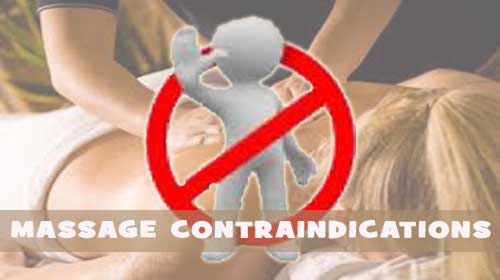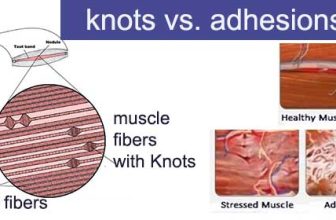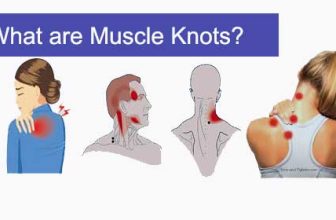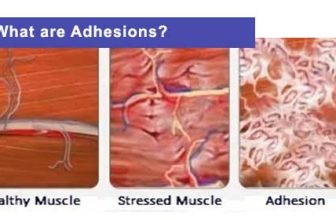
Contraindications for Massage:
As part of the assessment before performing massage therapy, the therapist must ask himself/ herself the following questions prior to treating a patient:
Does this patient have a pre-existing condition? – If yes, then:
- Could the application of massage exacerbate this condition?
- Could general massage aggravate this patient’s symptoms?
- Could massage cause or create problems that weren’t there before?
- Could massage place more stress on a body that is already in a highly stressed state?
- Could treating this patient be dangerous to the health of the therapist?
In cases where a patient is not entirely healthy, Massage Therapy is either locally, relatively, or absolutely contraindicated:
Massage Contraindication Definition:
Contraindication (sometimes abbreviated as CI or CI’s) is a condition that serves as a reason to withhold or refuse a treatment due to the harm that it would cause a patient, the therapist or other patients. (The opposite word for contraindication is ‘indication,’ which means the treatment is advised.) Contraindication in massage (Massage CI / Massage CI’s) means that massage treatment SHOULD NOT BE USED; Massage being contraindicated means massage should not be applied in the given condition or circumstance.
The following lists the conditions where I.Massage Is Totally, Completely or Absolutely Contraindicated, II.Massage is Relatively Contraindicated, and III.Massage is Locally Contraindicated.
ABSOLUTE Full Body Massage Contraindication: No Massage At All
In an absolute massage contraindication or total massage contraindication, Massage Therapy treatment is not suitable and is not recommended at all in any part of the body. This is to protect the patient from aggravated symptoms and to prevent exacerbation of their injury or disease. This may also be for the protection of the massage therapist from legal liability. In some cases, such as infections or contagious diseases, absolute contraindication to massage is for the safety of the massage practitioner and succeeding massage patients.
Massage is absolutely contraindicated for the following conditions:
- When patient is in shock, is having or just had a stroke, or a heart attack (acute stage)
- Intoxication (drugs and alcohol)
- High Fever
- Right After a Major Surgery.
- Meningitis
- Patients who are experiencing severe unexplained internal pain
- Hemorrhage (the escape of blood from vessels).
- Severe Atherosclerosis
- Acute Pneumonia
- Pregnant women who are suffering from Eclampsia
- Severe Hemophilia
- Advanced Kidney Failure
- Respiratory Failure.
- Liver Failure
- Appendicitis
- Highly Metastatic Cancers eg. lymphoma, malignant melanoma
- Diabetes Mellitus 1 or 2 with advanced heart or kidney disease or advanced vascular complications
- Sudden onset of severe undiagnosed headache
- Organ Failure.
- Pitting Edema
- Chronic active hepatitis
- (Infective and non-infective) endocarditis/pericarditis.
- Lung abscess or lung tumour
- Sepsis (blood infection) or Bacteremia (blood stream infections)
- If a patient has a contagious, airborne, infectious disease such as flu, colds, sore throat due to strep throat, shingles, etc.
- Patients with Infectious Skin Conditions (visit Contagious Skin Conditions Where Massage Should Be Avoided for more information)
For further information about Absolute Massage CIs, see the following link:
Absolute Massage Contraindications – Reasons Not To Get A Massage
Relative Contraindications to Massage
This means that Massage Treatment must be MODIFIED. Relative Massage Contraindication means that the massage therapist needs to carefully take into consideration the patient’s presenting condition (and health history) in order to prevent adverse effects. Modifications to the massage treatment may include change in pressure or direction of certain massage techniques, avoiding the use of certain massage techniques, shortening the massage treatment duration, staying away from an injured area, modifying the position of the patient on the massage table – using pillows or towels etc.
If a massage therapist is unsure, it is recommended that they contact (with the patient’s consent) their patient’s medical doctor and talk about their patient’s condition.
Relative/ Partial Massage Contraindications: The following conditions require treatment modifications:
- Aneurysm (may be absolute contraindication – it is recommended to get patient’s physician’s permission)
- Bell’s Palsy (see Bell’s Palsy Massage Procedure)
- Cancer
- Chronic Arthritic Conditions
- Chronic or Long Standing Thrombosis
- Conditions of Spasticity (Cerebral palsy, Hemiplegia, MS, spinal cord injury)
- Conditions of Rigidity such as Parkinsons disease
- Contusion
- Chronic Congestive Heart Failure
- Chronic Kidney Disease
- Debilitation
- Diabetes (see Contraindications for Diabetes Massage)
- Drug Withdrawal
- Epilepsy
- Fibromyalgia
- Flaccid Paralysis
- Fracture (see Massage for Bone Fractures )
- Frozen Shoulder (see Frozen Shoulder Massage Procedure)
- Hypertension and Hypotension
- Inflammatory Arthritides (Rheumatoid Arthritis (RA), Systemic Lupus Erythematosus (SLE), Rheumatoid arthritis (RA), systemic lupus erythematosus, gout, pseudo-gout, ankylosing spondylitis (AS), psoriatic arthritis (PsA), gonorrhea, tuberculosis, and osteomyelitis)
- Joint Dislocation (see Massage for Joint Dislocation)
- Joint Hypermobility / Joint Instability
- Kidney Infection / Kidney Stones
- Lymphedema
- Osteoporosis / Osteomalacia (see Osteoporosis Massage Procedure)
- Patients with Compromised Immune System
- Pregnancy (see Pregnancy Massage / Prenatal Massage Procedure)
- Raynaud’s Disease
- Recent Head injury
- Severe Asthma massage therapy contraindications
- Severe Emphysema c
- Seizure Disorders
- Spasmodic Torticollis (see Wry Neck Massage / Torticollis Massage)
- Temporomandibular Joint (TMJ) Disfunction (see Massage for TMJ)
- Uncontrolled High Blood Pressure
Massage Contraindications: ABSOLUTE Local CONTRAINDICATION
Massage Therapy in the Local Area is Contraindicated – NOT appropriate: This means that it is NOT advised to massage the local area that is affected. Massage for the surrounding area must be done with care (after a subjective and objective assessment).
- Areas of acute inflammation
- Acute Flare-Ups of Inflammatory Arthritides ( Rheumatoid Arthritis, Systemic Lupus Erythematosus, Ankylosing Spondylitis, Reiter’s Syndrome)
- Acute Neuritis (inflammation of a peripheral nerve or nerves, usually causing pain and loss of function)
- Burns (recent burns)
- (severe) Causalgia (severe burning pain in a limb caused by injury to a peripheral nerve)c
- Local Contagious Conditions ( note: some locally contagious conditions may be considered absolute contraindications such as athlete’s foot, warts, impetigo etc.)
- Deep vein thrombosis
- (undiagnosed) Lump, Cysts, Moles
- (during) Radiation therapy treatment
- Open Wounds or Sores
- Phlebitis contraindications for massage
- Severe Varicose Veins (see Massage for Varicose Veins)
- Thromboangiitis Obliterans (Buerger’s disease)
- (Acute) Trigeminal Neuralgia
- Venomous Bites or Stings
General Massage Precautions
- Take proper precautions when massaging acute injuries – make sure you are trained to treat the presenting condition in its acute stage (If local massage is contraindicated, careful ROM movements in the proximal joints may be helpful).
- Use proper pillowing techniques. For example, ensure that an injured body part is properly supported, use towels or pillows to prop up patients who have breathing difficulties.
- Massage areas of the body that are compensating to the injury.
- Massage is contraindicated over inflamed and painful areas.
- Be sensitive to non verbal cues from patient. Do not force a patient into a position they find uncomfortable.
- Remember to get patient consent and feedback during and after a modified massage treatment (just as in a regular massage therapy treatment).
- Do not massage skin areas that are open, bleeding, broken, weeping bodily fluids (blood, lymph, pus) as it may contain infectious agents, which could be transmitted to the massage therapist or other parts of the patient’s body.
- After replacing linens following each massage treatment, remember to also clean other surfaces in the therapy room such as door knobs, pens etc.
- Pay attention to patient’s allergies to avoid allergy attacks.



